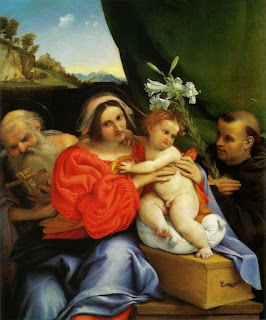Lilies have been a symbol of purity, hope, and rebirth as far back as ancient Greece. With the rise of Christianity, this flower became associated with the Virgin Mary. One can find depictions of the lily in European religious art dating back at least to the 14th century (more on that here). Over time, the connotation of rebirth made these flowers an obvious choice for Easter celebrations, when Christians celebrate the resurrection of Christ.
The lilies that have been so greatly admired for centuries in Europe are not the lilies that most Americans are familiar with. Europe has lilies that are native there, but the Easter Lily that we know is actually native to Japan. In the mid-19th century, Japanese bulbs were introduced to Bermuda and they did extremely well. In no time, Bermuda was providing 90% of these flowers to the US. Unfortunately, a virus struck in 1899 that decimated the crop (more here). After that, Japan was the only source for the lilies - until World War II changed everything. Luckily, a WWI soldier, on his way home to Oregon from Japan in 1918, had smuggled some Easter Lily bulbs into the country to share with family and friends. That little bit of federal lawbreaking literally provided the seed for the Easter Lily economy in the Pacific Northwest today. So, after bouncing from Japan to Bermuda and back to Japan; 99% of the Easter Lily bulbs sold in North America are now produced by four family farms in Smith River, CA. Quite a journey for a flower. Tulips may not carry the religious symbolism that lilies do, but they have long been a cheerful harbinger of spring. One of the first flowers to bloom in springtime, these colorful beauties are always a welcome sight. Easter just wouldn’t be the same without the sight of tulips. People commonly gift tulips at this time of year, and apparently, their different colors carry meanings to recipients much like roses do. I know I’d be happy with any color.Tulips are native to Central Asia, but we can thank the flower-lovers of the Ottoman Empire (based in modern-day Turkey)for introducing them to Europeans. The Ottomans prized these flowers and cultivated them in many colors and patterns. In the 17th century, Dutch tradesmen brought these beauties home. A quick side note: An important reason that lilies and tulips both traveled such great distances is their bulbs; unlike other types of flowers, bulbs take years to mature and can be transported in relative safety during this period.Once tulips arrived in the Netherlands, they quickly became an obsession for many. Tulip Mania (1634-1637) was the height of this obsession, when tulips became the world’s most expensive flower and bulbs were sold that cost more than mansions. While this phenomenon was short-lived, the cultural and economic circumstances are still being studied. Luckily for all of us who appreciate their beauty, the bust of Tulip Mania did not mean the end of tulips in the Netherlands. To this day, the Dutch remain the world’s largest commercial producer; they export about 3 billion yearly. They even have a National Tulip Day in January (more on that, and other cool festivals, here).
Tulips may be a national treasure in the Netherlands, but they have found a second home in Washington State. North of Seattle in the Skagit Valley, tulips have grown into a major industry that started with one man’s whim. George Gibbs, an English immigrant, was farming in the area in the 1890s when he randomly planted a few bulbs on his property. He dug them up a couple of years later and excitedly discovered that they had multiplied. With this new-found knowledge that the climate in Washington was perfect for tulip cultivation, he wrote to some Dutch growers for advice. Initially, they didn’t want to share their secrets, so he forged on without them. Later, though, he shipped some bulbs to them and they were so intrigued and impressed that they made the long trip to see his operation. From this one man’s dream, a world of tulips grew. Today, the Skagit Valley Tulip Festival attracts thousands every year from all over the world. If you’re in the area, the festivities start today and go through the end of April.While researching this blog, I was surprised to discover that both the Easter Lily and the tulip are edible. At least technically edible, most people do not claim they’re especially tasty. If you are interested in ingesting some beauty check out this article on eating tulips, which has an intense passage from a Dutch person who ate tulips when other food sources dried up during WWII. As far as Easter Lily food goes, this blogger is a real fan.
Take Care. Submitted by Pam











No comments:
Post a Comment